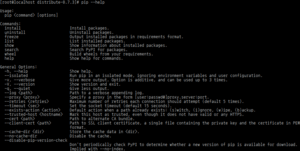pip (package manager)
|
An output of pip --help | |
| Initial release | April 4, 2011[1] |
|---|---|
| Stable release |
9.0.0[2]
/ November 2, 2016 |
| Repository |
github |
| Written in | Python |
| Operating system | OS-independent |
| Platform | Python |
| Type | Package management system |
| License | Free software[3] |
| Website |
pip |
pip is a package management system used to install and manage software packages written in Python. Many packages can be found in the Python Package Index (PyPI).[4]
Python 2.7.9 and later (on the python2 series), and Python 3.4 and later include pip (pip3 for Python 3) by default.[5]
pip is a recursive acronym that can stand for either "Pip Installs Packages" or "Pip Installs Python".[6][7]
Command-line interface

pip install virtualenvMost distributions of Python come with pip preinstalled. If pip is missing, it can be installed through the system package manager or by invoking
curl https://bootstrap.pypa.io/get-pip.py | python
One major advantage of pip is the ease of its command-line interface, which makes installing Python software packages as easy as issuing one command:
pip install some-package-name
Users can also easily remove the package:
pip uninstall some-package-name
Most importantly pip has a feature to manage full lists of packages and corresponding version numbers, possible through a "requirements" file.[4] This permits the efficient re-creation of an entire group of packages in a separate environment (e.g. another computer) or virtual environment. This can be achieved with a properly formatted requirements.txt file and the following command:
pip install -r requirements.txt
Install some package for a specific version python, where ${version} is replaced for 2, 3, 3.4, etc.:
pip${version} install some-package-name
Web hosting service use
Pip is used to support the use of Python in cloud web hosting, such as by Heroku.[8]
See also
References
- ↑ 1.0 release commit
- ↑ "Release Notes".
- ↑ "LICENSE.txt". github.com/pypa/pip. Retrieved 25 July 2015.
- 1 2 "pip documentation". The pip developers. Retrieved 5 January 2012.
- ↑ "pip installation". Retrieved 24 Feb 2015.
- ↑ "pip - ubuntuusers.de". ubuntuusers.de. Retrieved 17 February 2015.
- ↑ "What Does PIP Stand For?". Stack Exchange. Retrieved 17 February 2015.
- ↑ "Getting Started with Python on Heroku/Cedar". Dev Center. Heroku. Retrieved 5 January 2012.
